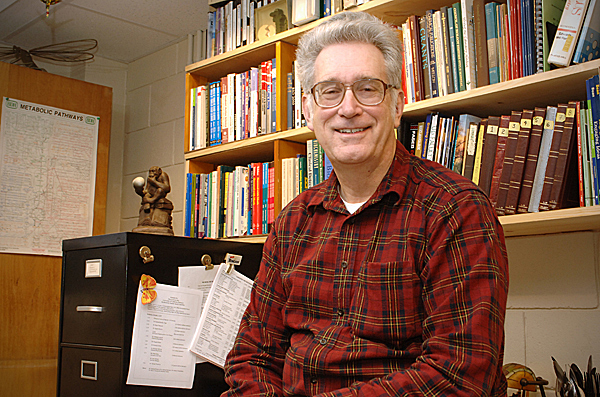
Observing dragonflies
UD biochemistry professor pens book on Delmarva's dragonflies
11:21 a.m., June 30, 2011--The Furtive Forktail dragonfly is one of 130 species of native dragonflies and damselflies on the Delmarva Peninsula. But, true to its name, this insect is so surreptitious that dragonfly expert Hal White has yet to spot one in Delaware, though he did see it in New York, years ago.
“I wouldn’t say it’s driving me crazy but I do hope to spot one locally someday,” says White.
People Stories
'Resilience Engineering'
Reviresco June run
The thrill of the hunt is why White has been chasing dragonflies for 50 years, since he was a boy in central Pennsylvania. Today, White is considered the state’s preeminent authority on dragonflies. But, surprisingly, he works at UD as a professor of biochemistry, not entomology.
“I decided to keep dragonflies as a hobby and pursue biochemistry as a profession,” he says.
White has been a success in both fields. In addition to a national reputation as a biochemistry educator, he has published dozens of articles about his hobby. And this spring, his first book on the subject, Natural History of Delmarva: Dragonflies and Damselflies: Essays of a Lifetime Observer, was released by the University of Delaware Press in collaboration with Delaware Nature Society.
Although the book can be used to identify species, it’s more than a field guide. White assembled a collection of stories that weave in knowledge about life cycles, behavior, physiology, evolution, ecology, natural selection and conservation. He also explains the difference between damselflies and dragonflies, which are part of the same suborder. The dragonfly is larger and holds its wings perpendicular to its body at rest; the smaller damselfly holds its wings parallel with the rest of its body.
Now’s the time to go dragonfly and damsel watching in Delaware. The adult population starts to appear in early spring, peaks in July and August and is gone by the first frost. Dragonflies and damselflies are found around water, where they gobble up mosquitoes, flies, gnats and other small, flying insects. Nymphs live underwater for months or even years before emerging; adults lay their eggs in water or nearby vegetation. Some species like the mill ponds and slow-moving streams of Sussex County, others prefer the faster-moving, rocky streams of the Piedmont.
One of White’s favorite places for dragonfly watching is Lums Pond in Bear. “I was at Lums Pond recently and counted 25 species in two hours,” says White. The variety of aquatic habitats at this state park almost guarantees you’ll see lots of dragonflies, particularly if you go on a warm, sunny day. Dragonflies and damselflies are strongly affected by changes in weather and hunker down on cool, rainy or windy days.
UD Cooperative Extension entomologist Brian Kunkel heads to White Clay Creek State Park for dragonfly watching. He appreciates their beauty – the dramatic blue markings of the Blue-Fronted Dancer damselfly, the red-heart-shaped markings on the Calico Pennant dragonfly. But the real fun comes from watching dragonfly behaviors, says Kunkel.
“The males in most species are really territorial,” says Kunkel. “They often sit on an elevated perch, ready to chase away other males. And it’s neat to see them make a mid-air capture of a mosquito.”
Jim White, associate director of biodiversity and land management for the Delaware Nature Society, contributed many photographs to White’s book. (The two are not related.) He recommends the DuPont Environmental Education Center in Wilmington and Abbott’s Mill in Milford for good dragonfly and damselfly viewing.
Abbott’s Mill manager Jason Beale and his wife, Magritte, equip their daughter, Sasha, and son, Cooper, with bug nets to collect dragonflies and damselflies, which they later release. Species that the Beales collected recently at Abbott’s include the Dragonhunter, Slaty Skimmer and Orange Bluet. And even two-year-old Cooper finds it easy to catch the Blue-tipped Dancer, which is found in abundance along the nature center’s walkways.
Learn more
“Natural History of Delmarva: Dragonflies and Damselflies” can be purchased from the University of Delaware Press, or at the Ashland Nature Center in Hockessin or the DuPont Environmental Education Center in Wilmington.
The 2011 Northeast Regional Meeting of the Dragonfly Society of the Americas will be held July 14-17 in Dover. This free conference is geared to professional entomologists as well as knowledgeable amateurs. Get details on Hal White’s webpage.
Article by Margo McDonough
Photo by Kathy F. Atkinson








